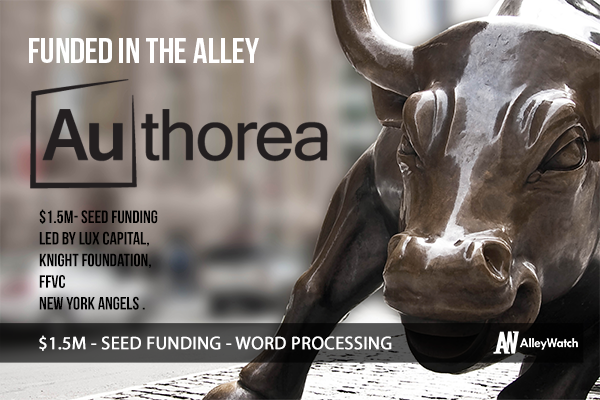Along with the incredibly important task of writing research papers come the annoying conventions that the paper requires. Columns, charts, sourcing the charts and so much more, and these are not simple to navigate on a Word or Google Doc. This is precisely why Authorea was made. Authorea combines all the necessary features from your everyday word processors and adds all the tools you need for collaborative research articles.
With a new round of funding, cofounder Alberto Pepe speaks with AlleyWatch about the creation and growth of the company along with where this newest round of funding will take them.
Who were your investors and how much did you raise?
It was a Seed-2 $1.5M financing round led by Lux Capital, with Knight Foundation, ffvc and New York Angels as participating investors. The round was closed at $1.03M and we’re leaving it open for a few weeks.
Tell us about your product or service.
Authorea.com is the collaborative platform to write, share, and discuss research. It was created in 2013 by a Harvard astrophysicist and a Berkeley physicist who met while working at CERN and were disappointed by the slow, inefficient, and obsolete ways by which research papers are written and disseminated. Described by many as a hybrid between Google Docs and Github for science, Authorea is a modern, web-native, Git-based environment where research findings are published, reviewed, and consumed openly. It is currently used by 85,000 researchers in the hard sciences and is rapidly growing in new research disciplines, in and outside of academia.
What inspired you to start the company?
My co-founder and I are recovering academics. We went through the pain of writing research and saw an opportunity for a tool when we realized how painful and inefficient it is to write and publish research papers collaboratively. It drive us nuts that it takes so long to write and publish a research paper (for the lack of collaborative tools). Slowing down the dissemination of research results has implications for society at large (consider for example, medical research).
How is it different?
Authorea is a collaborative editor for technical writers: researchers, students, and scholars. Imagine a Google Docs-like environment that makes you also add citations, references, equations, tables, data. This last point (data) is an important one; we’re truly rethinking scientific articles to be rich, data-driven, interactive objects rather than static PDFs.
What market you are targeting and how big is it?
There are roughly 20 million academics worldwide and 200 million college students that can benefit from Authorea’s scholarly writing features such as one-click-citation and one-click-formatting. In addition to that, Authorea has the potential to be a solid collaborative solution for researchers outside of academia – pharmaceutical companies, biotech, government, and the industry – who write technical documents, internal reports, R&D papers. These institutions would benefit especially from Authorea’s Git-based version control and the ability to create technical content in a white-labeled secure and private environment.
What’s your business model?
Fremium. Authorea is free, forever for publicly created (Open Access) content. We charge for privacy and extra features (such as group, lab, and institutional accounts)
Are you targeting the undergrad student market, or more of an academic market?
Initially, we built Authorea for researchers and scientists like us. But the more we show the product to college students, the more we think it fits well undergraduate needs for the writing of class notes, student papers, etc.
What was the funding process like?
Fundraising takes time and patience. It took about 6 months from the moment I started preparing a deck to closing of the financing. Overall, we’re extremely excited to see more VC firms interested in investing in science and the collaborative academic space.
What are the biggest challenges that you faced while raising capital?
At Authorea, we care deeply about our employees. Our main concern at all times is to keep them happy and pay them. During fundraising, you naturally end up living on the edge (of failure) and the biggest challenge is keeping the company spirit alive (and paying the employees).
What factors about your business led your investors to write the check?
We found two amazing new investors. Lux Capital, the lead, is a VC firm with an incredible track record and reputation in the scientific and academic fields. They invested because they understand we are building something that science needs. Similarly, Knight Foundation is a leader in media innovation, community engagement fostering the art and sciences.
What are the milestones you plan to achieve in the next six months?
Traction traction traction.
What advice can you offer companies in New York that do not have a fresh injection of capital in the bank?
If you can build a product people love, build that product, sell it, and stay afloat without the need of investor capital. I am a fan of bootstrapping and breaking even.
Where do you see the company going now over the near term?
My concern in the near term is building a great team and hopefully instilling it with a great company culture. We’re a mission-backed company, so we’re lucky because we find passionate individuals that share our passion for making academia and collaborative writing better.
Where is your favorite bar in the city for an after work drink?
After work (we’re based in Flatiron), I often go back to “the other side”, in Williamsburg or Greenpoint, where I live. The Brooklyn Winery is a great wine bar very close to the Bedford L stop.




